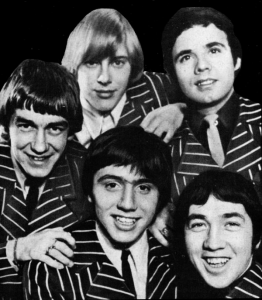
Last Sunday the ABC showed the first part of a show about The Easybeats, the first internationally successful rock band coming from downunder.
“Populate or perish” was a rallying cry of the first Minister for Migration, Arthur Calwell, after World War II. He initiated the Assisted Passage Migration Scheme to lure Europeans to our shores, with cheap tickets (hence the “Ten Pound Poms”) and the promise of an everyday holiday under the Southern sun and the country’s endless beaches.
Among the arrivals in 1964 were five young lads from Scotland, England and the Netherlands.
However, at arrival the migrants found themselves miles away from this, as they were sent to the Villawood Migrant Hostel, 25 km away from Sydney and its beaches. The families lived in small huts, sometimes shared with meter long snakes which came in from the surrounding bush, and were roaming around idly. Which was not without its own perils, there were fights born out of rivalry about girls, casual racism and pure boredom.
George Young, one of the siblings of the Young family from Glasgow who should write rock history (his younger brothers Malcolm and Angus founding AC/DC years later), met two young men from the Netherlands, who named themselves Harry Vanda and Dick Diamonde, and started a friendship over a few guitar riffs they played in the washhouse. They were joined by Little Stevie who came from Leeds a few years earlier and lived nearby. Looking for a drummer, they found Gordon “Snowy” Fleet from Liverpool, who was already a family man with wife and child.
Soon the band of five were playing in Sydney and started to hit the road, managed by real estate agent Mike Vaughan. He was another piece in the puzzle that sent the Easybeats to stardom: He knew Ted Albert whose family owned J.Albert & Sons and who was determined to start a new chapter in the family business by producing rock and pop music.
He recorded their first singles. “She’s So Fine” gave them their first real hit, reaching no.3 in the Australian charts. Their concerts became rowdy and wild, the girls went crazy. Australia hadn’t seen it since Beatlemania, and the media dubbed it “Easyfever”.
There is a scene of a “home evasion” of the Young family home. The press leaked the address and plenty of mainly female fans went there and stormed into the house. When Angus Young, probably 10 years old, arrived he gets stopped by the police trying to keep the fans out. “I just live here”, he says. “Yeah yeah, they’re all saying that.” Finally reaching home, George slumps on his bed, just to find out that one girl is hiding underneath. With a grin and a wink she crawls out.
Being on top in Australia, the Easybeats decided to take on the world. Vaughan got United Artists Records to sign the Easybeats, and in 1966 they relocated to London and found themselves in EMI’s Abbey Road Studios where the Beatles had recorded before.
Ted Albert was with them but was sent home: United Artists were not happy with the first songs he had recorded with the band. It may have been a humiliation for him but he continued to record some of the most important Australians musicians in the years to come. His story is told in the documentation “Blood + Thunder” which is shown at the ABC after the Easybeats story (and on iView as well).
Still in London, the Easybeats struggle to write new songs. One night they see a French group of vocalists, The Swingle Singers. On the way home and afterwards, they mucked around some background vocals they heard because they thought of them ridiculous and cringeworthy. Still they get hooked and transform it into a guitar melody, until it finally sounded good, as Harry Vanda remembers. This was the backbone of what should become their biggest hit: “Friday On My Mind”.
This Sunday, 3rd Dec at 8.40pm, the ABC will show the second part of the story, of some migrants who became Australians and conquered the world. If you missed the first part, you still can catch up on iView.
